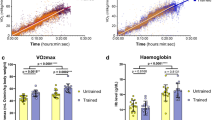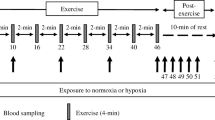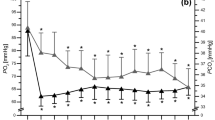Summary
Oxygen dissociation curves (ODC) in whole blood and organic phosphate concentrations in red cells were determined in 10 highly trained male athletes (TR), 6 semitrained subjects (ST) who played sports regularly at low intensities and 8 untrained people (UT). In all groups standard ODCs (37‡ C, pH 7.40, Pco2∼43 Torr) at rest and after a short exhaustive exercise were nearly identical, but P o2 values measured immediately after blood sampling and corrected to standard conditions tended to fall to the right of the in vitro ODC. Elevated P50 in the physically active [28.6±1.4 Torr (3.81±0.18 kPa) in ST, 28.0±1.1 Torr (3.73±0.15 kPa) in TR, but 26.5±1.1 Torr (3.53±0.15 kPa) in UT] were partly caused by different [DPG] (11.9±1.3 Μmol/gHb in UT, 13.3±1.5 Μmol/gHb in TR, 13.8±2.2 Μmol/gHb in ST). There were remarkable differences in the shape of the curves between the groups. The slope “n” in the Hill plot amounted to 2.65±0.12 in UT, 2.74±0.12 in ST and 2.90±0.11 in the TR (2 p against UT<0.001), leading to an elevated oxygen pressure of about 2 Torr (0.27 kPa) at 20% saturation and an augmented oxygen extraction of 5–7 So2 at a Po2 of about 15 Torr (2 kPa), which might be favorable at high workloads.
The reason for the phenomenon could be an increased amount of young red cells in the blood of TR, caused by exercise induced hemolysis.
Similar content being viewed by others
References
Adlercreutz, H., HÄrkönen, M., Kuoppasalmi, K., Kosunen, K., NÄveri, H., Rehunen, S.: Physical activity and hormones. Adv. Cardiol. (Manninen, V., Halonen, P. J., eds.), Vol. 18, pp. 144–157. Basel: Karger 1976
Arturson, G., Garby, L., Robert, M.: The oxygen dissociation curve of normal blood with special reference to the influence of physiological effector ligands. Scand. J. Clin. Lab. Invest. 34, 9–13 (1974)
Benesch, R., Benesch, R. E.: The effect of organic phosphates from human erythrocyte on the allosteric properties of hemoglobin. Biochem. Biophys. Res. Comm. 26, 162–166 (1967)
Bille-Brahe, N. E., Kehlet, H., Madsbad, S., Rörth, M.: Effects of androgens on oxygen affinity in vivo and 2,3 DPG content of red cells in peripheral arterial insufficiency. Scand. J. Clin. Lab. Invest. 36, 801–804 (1976)
Böning, D., Schweigart, U., Tibes, U., Hemmer, B.: Influences of exercise and endurance training on the oxygen dissociation curve of blood under in vivo and in vitro conditions. Eur. J. Appl. Physiol. 34, 1–10 (1975)
Böning, D., Draude, W., Trost, F., Meier, U.: Interrelation between Bohr and temperature effects on the oxygen dissociation curve in men and women. Resp. Physiol. 34, 195–207 (1978)
Bonner, H. W., Tate, C. A., Buffington, C. K.: Changes in erythrocyte 2,3 Diphosphoglycerate in women following short-term maximal exercise. Eur. J. Appl. Physiol. 34, 227–232 (1975)
Bunn, H. F., Ransil, B. J., Chao, A.: The interaction between erythrocyte organic phosphates, magnesium ion, and hemoglobin. J. Biol. Chem. 246, 5273–5279 (1971)
Clausen, J. P., Trap-Jensen, J.: Effects of training on the distribution of cardiac output in patients with coronary artery disease. Circulation 40, 143–154 (1969)
Doll, E., Keul, J.: Zum Stoffwechsel des Skelettmuskels. II. PO2, PCO2, pH, Standardbicarbonat und B.E. in venösem Blut der arbeitenden Muskulatur. Untersuchungen an Hochleistungssportlern. Pflügers Arch. Ges. Physiol. 301, 214–229 (1968)
Duhm, J., Gerlach, E.: Metabolism and function of 2,3 Diphosphoglycerate in red blood cells. In: The human red cell in vitro, (Greenwaldt, J., Jamieson, G. A., eds.), pp. 111–152. London, New York: Grune and Stratton 1974
Ekblom, B., Goldbarg, A. N., Gullbring, B.: Response to exercise after blood loss and reinfusion. J. Appl. Physiol. 33, 175–180 (1972)
Finch, C. A., Lenfant, C.: Oxygen transport in man. N. Engl. J. Med. 286, 407–415 (1972)
Hasart, E., Roth, W., Jagemann, K., Pansold, B.: 2,3-Diphosphoglyceratkonzentration in Erythrozyten und körperliche Belastung. Med. Sport 13, 112–118 (1973)
Kostuk, W. J., Suwa, K., Bernstein, E. F., Sobel, B. E.: Altered hemoglobin oxygen affinity in patients with acute myocardial infarction. Am. J. Cardiol. 31, 295–299 (1973)
Magazanik, A., Shapiro, Y., Meytes, D., Meytes, I.: Enzyme blood levels and water balance during a marathon race. J. Appl. Physiol. 26, 214–217 (1974)
Malmström, G., Sjöstrand, T.: Physiological variations in endogenous formation of carbon monoxide. Acta Physiol. Scand. 27, 231–241 (1953)
Mitchell, J. H., Sproule, J. B., Chapman, C. B.: The physiological meaning of the maximal oxygen intake test. J. Clin. Invest. 36, 538–546 (1958)
Neville, J. R.: Erythrocyte age and shape of the oxygen dissociation curve. Proc. Inter. Physiol. Sci. 23, 548 (1977)
Rand, W. P., Norton, J. M., Barker, N., Lovell, M.: Influence of athletic training on hemoglobin-oxygen affinity. Am. J. Physiol. 224, 1334–1337 (1973)
Rasmussen, B., Klausen, K., Clausen, J. P., Jensen, J.: Pulmonary ventilation, blood gases and blood pH after training of the arms or legs. J. Appl. Physiol. 38, 250–256 (1975)
Rougier, G., Babin, J. P.: Influences des activites physiques sur les electrolytes seriques et musculaires. Path. Biol. 17, 411–427 (1969)
Severinghaus, J. W.: Blood gas calculator. J. Appl. Physiol. 21, 1108–1116 (1966)
Shappell, S. D., Murray, J. A., Nasser, M. G., Wills, R. E., Torrance, J. D., Lenfant, C. J. M.: Acute change in hemoglobin affinity for oxygen during angina pectoris. N. Engl. J. Med. 282, 1219–1224 (1970)
Shappell, S. D., Murray, J. A., Bellingham, A. J., Woodson, R. D., Detter, J. C., Lenfant, C.: Adaptation to exercise: Role of hemoglobin affinity for oxygen and 2,3 Diphosphoglycerate. J. Appl. Physiol. 30, 827–837 (1971)
Shaw, A. L., Messer, A. C.: The transfer of bicarbonate between the blood and tissues caused by alterations of the carbon dioxide concentration in the lungs. Am. J. Physiol. 100, 122–136 (1932)
Shojania, A. M., Israels, C. G., Zipursky, A.: The relationship of ATP concentration to erythrocyte aging. J. Lab. Clin. Med. 71, 41–48 (1968)
Taunton, J. E., Taunton, C. A., Banister, E. W.: Alterations in 2,3 DPG and P50 with maximal and submaximal exercise. Med. Sci. Sports 6, 238–241 (1974)
Thomson, J. M., Dempsey, J. A., Chosy, L. W., Shahidi, N. T., Reddan, W. G.: Oxygen transport and oxyhemoglobin dissociation during prolonged muscular work. J. Appl. Physiol. 27, 658–664 (1974)
Vanzetti, G., Valente, D.: A sensitive method for the determination of hemoglobin in plasma. Clin. Chim. Acta 11, 442–446 (1965)
Varnauskas, E., Björntorp, P., Fahlén, M., Pérovsky, I., Stenberg, J.: Effects of physical training on exercise blood flow and enzymatic activity in sceletal muscle. Cardiovasc. Res. 4, 418–422 (1970)
Wilson, D. F., Erecińska, M., Drown, C., Silver, I. A.: Effects of oxygen tension on cellular energetics. Am. J. Physiol. 233, 135–140 (1977)
Author information
Authors and Affiliations
Rights and permissions
About this article
Cite this article
Braumann, K.M., Böning, D. & Trost, F. Oxygen dissociation curves in trained and untrained subjects. Europ. J. Appl. Physiol. 42, 51–60 (1979). https://doi.org/10.1007/BF00421104
Accepted:
Issue Date:
DOI: https://doi.org/10.1007/BF00421104




